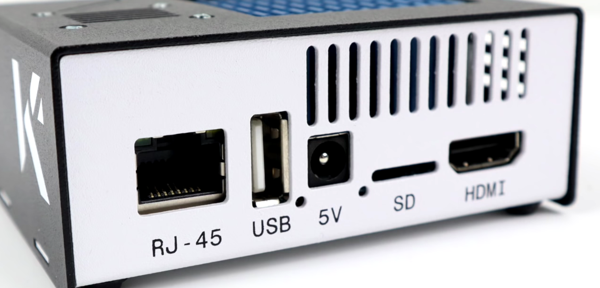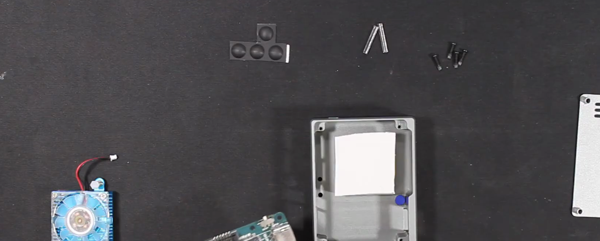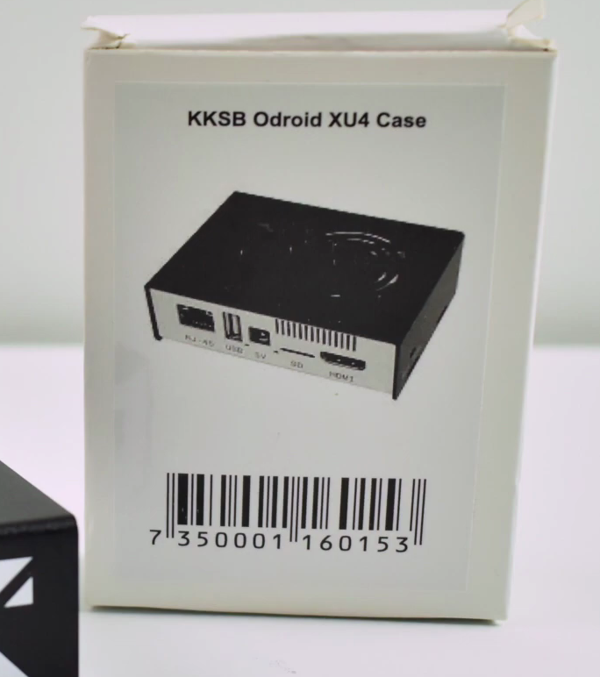Note: As an Amazon Associate I earn from qualifying purchases.
Review: Using the KKSB Odroid XU4Q Aluminum Case with Fan (2024)
Introduction
I recently obtained the KKSB Odroid XU4Q Aluminum Case. Below are my thoughts on its design, cooling capacity, simplicity of assembly, and included accessories. For those who frequently work with single-board computers - as you know - it’s not just about protection but also functionality and thermal efficiency (and aesthetics / noise…).
Specifications
| Property | Value | Property | Value |
|---|---|---|---|
| Brand | KKSB Cases | Case Type | Mid Tower |
| Color | Black and White | Cooling Method | Air |
| Model Name | KKSB XU4Q Case | Item Weight | 120 Grams |
| Hard Disk Form Factor | 3.5 Inches | Compatible Devices | CPU |
Photos
Click on photos to enlarge them:
Prices
Check prices of the KKSB Odroid XU4Q Aluminum Case on:
Overall Design Aesthetics

The modern aesthetics of the KKSB Odroid XU4Q Aluminum Case with its black and white color scheme blend easily with any desk setup, providing a touch of sophistication. The sleek design is further complemented by its aluminum construction, which gives a sense of durability and premium quality compared to typical plastic cases. Let me walk you through some of my thoughts on this case:
Visual Appeal: The contrast of black and white is pleasing and allows the case to stand out among other computer components.
Material Choice: The use of aluminum not only looks good but also contributes to the case’s cooling capabilities.
Design Practicality: The case maintains functionality with accessible ports and a push button that corresponds to the Odroid XU4Q board.
The housing does a good job doubling as a heat sink, a clever design choice that enhances its cooling efficiency. In my experience, the housing also doesn’t add much bulk to the Odroid XU4Q, keeping the form factor compact and manageable on my workspace.
A potential drawback to consider is that, while the case is aesthetically pleasing, the fan noise can be a downside. My experience is different with the fan, as it tends to be loud and noticeable in a quiet room. Although one expects active cooling fans to make some noise, I find the sound level here to be on the higher side for my taste.
Another point to bear in mind is the top cover assembly. While it fits, it does not feel as secure as I would like. I prefer hardware that snaps or screws into place with a sense of permanence; this case doesn’t quite deliver that level of solidity in its top cover design. Yet, it holds together well enough for regular use without moving around.
Here’s a quick run-through of the overall design aesthetics:
Pro: Sleek, modern look with a fine combination of colors.
Con: The fan can be distractingly loud at times.
Pro: Lightweight without compromising on sturdiness due to aluminum construction.
Con: The fit of the top cover could be improved for a more secure feel.
In the realm of single-board computer cases, I appreciate that KKSB has managed to provide a design that is thoughtful in terms of heat dissipation and visual appeal. However, the fan noise and the top cover’s fit are areas that could use some attention in future versions.
Overall, my personal opinion leans towards a positive outlook on the KKSB Odroid XU4Q Case. It’s clear that the Swedish team has put effort into creating a product that not only looks good but also serves a practical function in cooling the single-board computer. Despite some minor issues, it’s a case I would recommend for those looking for a balance between function and style.
Cooling Performance

When assessing the cooling performance of the KKSB Odroid XU4Q aluminum case with fan, several features stand out that enhance the thermal management for the single-board computer:
The case is made of aluminum which naturally has good thermal conduction properties.
It is a two-piece design intended to act as a heat sink, drawing heat away from the device.
The built-in fan is a proactive feature intended to offer additional cooling, especially in challenging temperature conditions or during CPU overclocking.
In my usage, I found that the aluminum housing does an exceptional job of passive cooling. The material choice for the case is excellent as aluminum efficiently dissipates heat, and the design ensures that the heat is transferred away from the core components of the Odroid XU4Q promptly.
However, in scenarios where the Odroid is pushed to its limits, the active cooling fan comes into play. The addition of the fan is good foresight for scenarios where passive cooling isn’t sufficient. Despite the fan’s presence, there are areas for potential improvement.
Here’s a summary of my thoughts on the cooling performance:
Pros:
Aluminum case acts as a heat sink.
Fan provides additional active cooling.
Design accounts for heat dissipation in intensive operations.
Cons:
The fan can be loud and distracting, which could be an issue in quiet environments.
There have been mentions that the fan doesn’t lower the CPU temperature significantly.
The fan*cutouts** could be larger for better airflow.
The aluminum housing’s ability to double as a heat sink is one of the biggest advantages of this case. I noticed a stable operational temperature during general use without the fan even kicking in.
However, I observed that the fan, when operational, does contribute to noise. Although not unbearable, this could be a drawback for users sensitive to sound or those using the XU4Q in sound-critical environments. In some cases, I found the fan noise to be a bit obnoxious, which contrasts with the sleek and professional look of the case.
I haven’t overclocked my device, thus the fan has mostly been an additional precaution rather than a necessity. However, the fan design could be improved to create a balance between noise and cooling efficiency, potentially by using a quieter fan or optimizing the case’s airflow design to make the most of the fan’s capabilities.
Overall, while the active cooling is not perfect due to the fan noise, I appreciate the overall approach to managing temperature with a combination of both passive and active cooling strategies. The aluminum body of the case without a doubt plays a substantial role in keeping the device cool. With some tweaks, especially to the active cooling setup, this case’s cooling performance could move from good to great.
Ease of Assembly

When it comes to putting together the KKSB Odroid XU4Q Aluminum Case, I appreciate the straightforward process which didn’t require a lot of time or any special tools. The case design features a two-piece snap-fit mechanism, which makes assembling and disassembling a breeze. This is great for someone like me who appreciates efficiency and simplicity in setup. However, there are some considerations to keep in mind:
Easy Snap-Fit Design: The two-piece case clicks together easily, making the initial setup hassle-free.
Accessible Ports and Buttons: Cutouts are well-aligned, which means I don’t have to struggle to plug in cables or access ports.
Rubber Feet and Mounting Holes: Adding to the case’s stability and placement options, it saves me from purchasing additional accessories.
One drawback is the fan installation. The fan noise could be a turn off for some, especially if you’re sensitive to sound or planning to use the XU4Q in a quiet environment. Additionally, although I found that the top cover did fit, it didn’t feel as secure as I hoped, causing a slight concern over the long-term durability of the snap-fit design.
From a personal perspective, I can say the overall assembly experience is positive. It’s the kind of straightforward process that doesn’t leave you scrolling through forums or looking up tutorial videos, which I particularly like. But I also recognize that the fan could be quieter and the fit could feel a bit more secure.
Constructing the case was almost intuitive, not having to deal with screws and screwdrivers made it less daunting, especially for less tech-savvy individuals. From my point of view, assembling the KKSB Odroid XU4Q case is largely a positive experience, marred only slightly by some minor concerns with the fan and top cover.
For anyone looking to set up their single-board computer with minimal fuss, this case could be a solid choice. Yet, the potential need to seek out a quieter fan could introduce another step. In my case, the ease of setup combined with the sleek design has tilted my opinion favorably towards the KKSB Odroid XU4Q case, despite some room for improvement.
Case and Accessories Quality

In the realm of single-board computing, the overall experience is often influenced by not only the performance of the board itself but also the quality of the accessories that accompany it. Focusing specifically on the KKSB Odroid XU4Q case, I’ve observed it offers a balance between style, functionality, and durability, with an emphasis on maintaining the integrity of the board.
Pros:
Durable aluminum construction — enhances the case lifespan and aesthetics.
Accessibility to ports — ensures no hindrance to connectivity.
Non-slip rubber feet — provide stability on various surfaces.
Wall-mounting option — introduces versatility in placement.
Cons:
Fan noise — can be a little intrusive in quiet environments.
Lack of built-in heatsink — a potential missed opportunity for enhanced cooling.
The aluminum housing certainly adds a premium feel and the simple black and white color scheme fits well with most tech environments. On a practical note, the freely accessible ports and operational push button are something I greatly appreciate, as these features contribute to a hassle-free experience when connecting peripherals.
Mounting the board inside the case is a straightforward affair due to the snap-fitting design, yet the security of the top cover could be improved. It’s not a deal-breaker, but an area where a bit of refinement would be welcome. Four non-slip rubber feet are a minor, yet thoughtful touch, ensuring the case stays put, which can be crucial in setups where accidental bumps might occur.
Receiving the case along with the fan and fasteners is a much-appreciated approach, considering some manufacturers omit essential components, causing delays in setup. However, I must address the fan noise; although it is by no means unbearable, it is noticeable, which might irk those with a preference for quieter operation. Some might find this a fair trade-off for the enhanced cooling it provides, but I can see others opting to disconnect it if the passive cooling suffices.
The absence of a built-in heatsink might be seen as a missed opportunity. While not essential for every user, enthusiasts who push their systems may have appreciated this added element, helping to justify the case’s cost further and optimize cooling further.
In conclusion, the KKSB Odroid XU4Q case is a solid choice for those seeking durability and easy access to their single-board computer’s ports and buttons. It’s evident that attention has been given to the case’s usability, although there’s room for minor improvements regarding fan noise and the robustness of the top cover’s fitting. For the price point and considering its straightforward assembly, it stands as a worthwhile investment, especially for users whose priority is maintaining their SBC’s longevity and stability during use.



